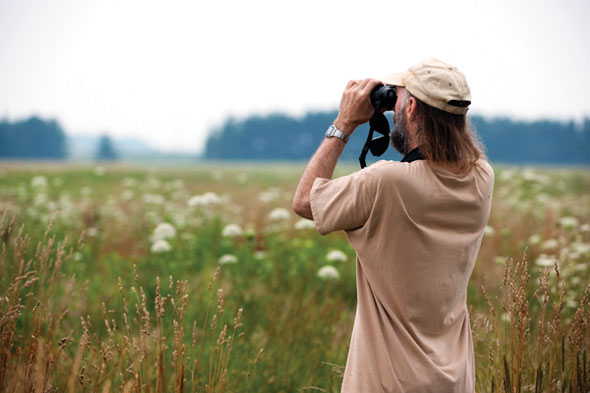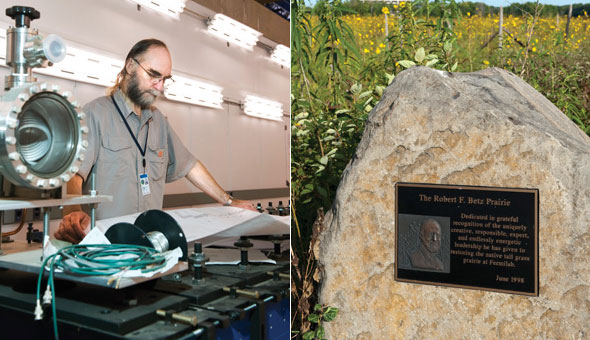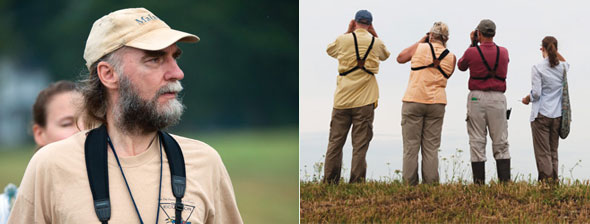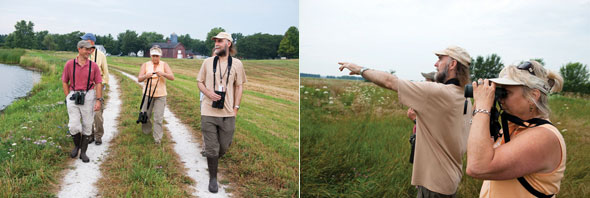Day in the life: Peter Kasper
In a birder's paradise
By Daisy Yuhas
 |
For birders, it all comes down to that moment. Focus your binoculars, steady your hands, and look, hard, until you find that glimpse of feathers, a spark of recognition.
Do you see it?
Peter Kasper points over the field and across, to where the caps of Queen Annes Lace dance in the breeze and a discerning eye can just make out a slight brown blob—a Henslows Sparrow, an uncommon bird in the state of Illinois.
Fermi National Accelerator Laboratory is home to more than 280 species of birds, including several endangered species, and a way station for unusual migrants.
Accelerator physicist Peter Kasper monitors the site avidly. He has been birding since the fourth grade, when he saved up pocket money for binoculars and one of the first bird books ever written for his home country, Australia. While he joins in far-flung expeditions across continents with fellow birders and physicists, its Fermilab that he prowls with binoculars every week. He knows the birds that come and go like old neighbors or friends.
In the early years, it was really an exploration, Kasper says. Now I know this site like the back of my hand.
 |
| Ospreys soar, egrets stalk fish, and pelicans float in Fermilabs natural areas. Pelicans, whose migration route takes them west of the lab, have visited the site only twice; still, a group of 200 arrived this year. From top, photos by Reidar Hahn, Fermilab; Brian Chase; and Greg Vogel |
When Kasper joined the Accelerator Division at Fermilab in 1986, he encountered 6800 acres of land that were rich in potential for birding discoveries.
The laboratory has been a haven for naturalists and ecologists since at least the 1970s, when Professor Robert Betz of Northeastern Illinois University began leading a project to restore Fermilabs prairie land. Volunteers, including lab and local park district staffers and nature enthusiasts on and off site, formed the Ecological Land Management Committee to promote the restoration of the labs tall-grass prairie. Later its scope expanded to embrace Fermilabs woodlands, savannah, and other ecosystems.
Fermilab has one of the more diverse ranges of habitats—and therefore impressive species richness—of any of the preserves within DuPage and Kane counties, says Diann Bilderback, former president of the DuPage County Birders Club.
The committee has worked with the labs Roads and Grounds Department, which implements its land-management suggestions, to turn the site into a showcase for native plants and a sanctuary for wildlife.
 |
| Above: Physicist Peter Kasper reviews drawings of shielding that will enclose the High Intensity Neutrino Source (HINS) Linac R&D Facility at Fermilab. |
Dave Spleha, who has accompanied Kasper for more than a decade, says, A lot of Fermilab is closed to the general public. Its more untouched than local forest reserves. As a result, he says, the areas that are open for birding let you see birds that are hard to find anywhere else in the local counties.
As one of only seven National Environmental Research Parks established by the Department of Energy, Fermilab also welcomes research by scientists outside the lab. One NERP project, which is evaluating native prairie grasses as potential sources of biofuel, has also created an array of birding possibilities. Plots seeded only two years ago are already attracting birds, giving birders a chance to coo over the lilting flight of Sedge Wrens, sunny yellow Dickcissels, and piebald Bobolinks.
 |
| From top left: Sandhill crane, osprey, and great horned owl. Photos by Gene Oleynik (crane) and Reidar Hahn |
Kaspers bird surveys are also an official NERP project, though he started conducting them before the laboratory became a research park. Since the late 1980s, he has maintained a website and daily log—among the first websites and blogs ever created—where he tracks bird numbers at Fermilab. He is assisted in monitoring Fermilab year round by Spleha and Denis Kania, ecological restoration supervisor for the St. Charles Park District.
The trio leads and organizes annual spring and Christmas bird counts, the latter being a nationwide Audubon Society effort to track bird species. Throughout the year they stay on top of reported sightings and changes in Fermilabs bird populations.
In their years of birding, they have observed many shifts in the numbers and behaviors of Fermilab birds. Some are positive, as when restoration efforts create more habitat; others are worrisome, such as the increasing presence of birds that normally range farther south, likely due to climate change.
 |
| Photos: Reidar Hahn, Fermilab |
One happy return this summer was Fermilabs osprey pair. The osprey is one of Kaspers favorites—a majestic bird of prey, endangered in Illinois. The pair returned for a second year to their impressive branch-built nest, feeding their young with fresh-caught fish from the labs many lakes and ponds.
Kasper can recall many instances of birds returning year after year to establish themselves for the season in a particular spot, sometimes only a few meters wide. Diving ducks, he notes, have mysteriously taken to the moat over the main injector, and hes fascinated by their little behavioral quirks.
Birds are strange. Its part of what I find dramatic about them, Kasper says. These birds have such curious site loyalty. Its clear they view the world in a way thats completely different from us.
Perhaps its also clear that like the birds who return to Fermilab again and again, these birders have found their niche.
 |
| Photos: Reidar Hahn, Fermilab |
Click here to download the pdf version of this article.






